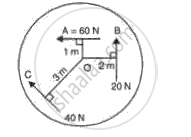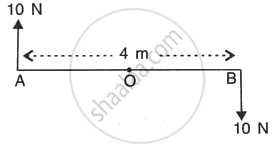Advertisements
Advertisements
प्रश्न
Three forces A, B and C are acting on a rigid body which can turn about O in fig.9. If all the three forces are applied simultaneously, in which direction will the body move? Explain.

उत्तर
The body will move in the direction of net torque
Net torque = sum of clockwise moments - sum of anticlockwise moments
In the given figure, force 40N is acting clockwise and forces 20N and 60N are acting anticlockwise
Net torque = (40 x 3) - [(20 x 2) + (60 x 1)}
= 120 - 100
= 20 Nm
Hence the body will move in clockwise direction about 'O'
APPEARS IN
संबंधित प्रश्न
How does the effect of force differ when it is applied on a rigid body?
A wheel of diameter 2 m can be rotated about an axis passing through its center by a moment of force equal to 2·0 N m. What minimum force must be applied on its rim?
State the relationship between force, mass and acceleration. Draw graphs showing the relationship between Acceleration and force for a constant mass.
State two factor on which moment of force about a point depends.
State one way to reduce the moment of given force about a given axis of rotation.
Give two examples of a couple's actions in our daily life.
Two forces each of magnitude 10 N act vertically upwards and downwards respectively at the two ends A and B of a uniform rod of length 4 m which is pivoted at its midpoint O as shown in the figure. Determine the magnitude of the resultant moment of forces about the pivot O.

What is the work done when no net force is applied on the body?
Fig. shows a uniform meter scale weighing 100 N pivoted at its centre. Two weights of 500 N and 300 N are hung from the ruler as shown in fig.

(i) Calculate total clockwise and anticlockwise moments.
(ii) Calculate difference in clockwise moment and anticlockwise moment.
(iii) Calculate the distance from O where a 100 N weight should be suspended to balance the meter scale.
How does the distance of separation between two bodies affect the magnitude of the non-contact force between them?
